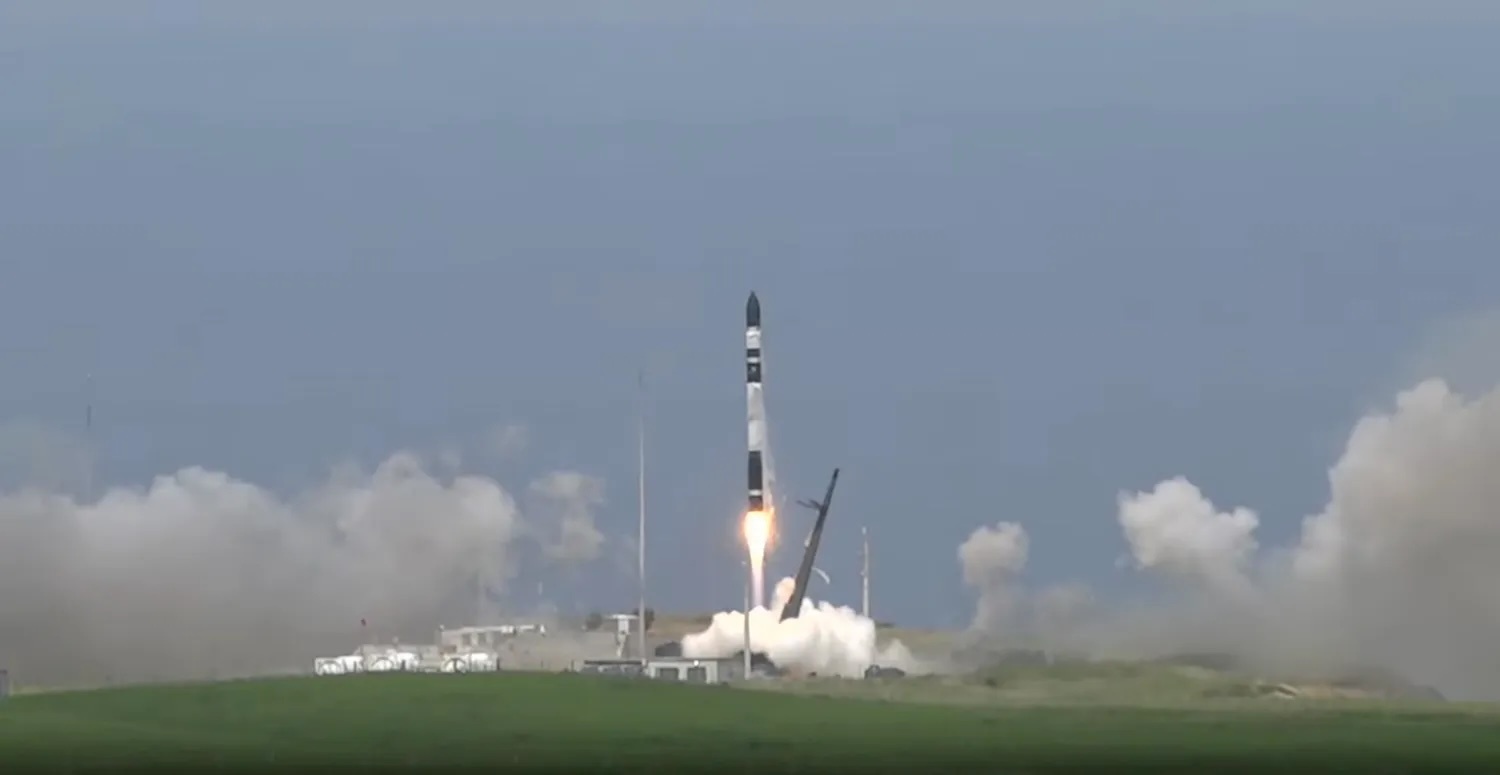20.02.2025

A Rocket Lab Electron lifts off Feb. 18 carrying a BlackSky imaging satellite. Credit: Rocket Lab webcast
WASHINGTON — Rocket Lab launched the first in a new generation of imaging satellites for BlackSky Feb. 18 at almost the same time SpaceX achieved a new milestone in recovery of Falcon 9 boosters.
A Rocket Lab Electron rocket lifted off from Pad B at the company’s Launch Complex 1 in New Zealand at 6:17 p.m. Eastern. The payload for the “Fasten Your Space Belts” mission, a BlackSky imaging satellite, deployed from the kick stage about 55 minutes later, with a planned circular orbit of 470 kilometers at an inclination of 59 degrees.
The spacecraft is the first Gen-3 satellite for BlackSky’s imaging constellation. The Gen-3 satellites can provide imagery at a resolution of 35 centimeters as well as perform observations at short-wave infrared wavelengths that can penetrate smoke and haze. The satellites also have optical intersatellite links to decrease latency.
“This launch represents a major inflection point for our global defense and intelligence customer base as BlackSky introduces very high-resolution Gen-3 capabilities to our high-frequency, low-latency monitoring constellation,” Brian O’Toole, chief executive of BlackSky, said in a Feb. 10 release about the upcoming launch.
He added that BlackSky planned “a regular cadence of additional launches over the coming year” but did not offer specifics. BlackSky signed a contract in August 2023 for five Electron launches.
This was the second Electron launch of the year and the 60th for the vehicle overall. The company has not disclosed a projected number of Electron launches for the year beyond estimating it will be more than the 16 Electron missions in 2024. The company said on its launch webcast that the next Electron launch was planned from New Zealand in “a few short weeks.”
Rocket Lab is scheduled to release financial results for 2024, which may include projections for 2025, on Feb. 27.
SpaceX lands in the Bahamas
While the Electron carrying the BlackSky satellite was still on its way to orbit, SpaceX launched a Falcon 9 from Cape Canaveral Space Force Station at 6:21 p.m. Eastern. The rocket deployed its payload of 23 Starlink satellites about 65 minutes later.
The notable aspect of this launch was that the Falcon 9 first stage performed a droneship landing in waters near the Exuma Islands in The Bahamas. It marked the first time SpaceX conducted a landing there and the first Falcon 9 booster landing in the waters of another country.
SpaceX said landing the booster in The Bahamas opens up new trajectories for Falcon 9 launches from Florida. That includes the upcoming Fram2 private astronaut mission, which will fly to polar orbit. It also provides alternative landing locations for launches in the winter months when weather conditions in the North Atlantic can be unfavorable.
“This is significant for The Bahamas in so many ways,” Isaac Chester Cooper, deputy prime minister of the country, said during the SpaceX webcast of the launch. He argued that the landing gave the country a foothold in the aerospace industry and provide both educational outreach and tourism opportunities.
“We recognize that safety is put first and foremost. We’ve ensured that we’ve done the due diligence and we’ve done our work to deliver this first international landing,” he said, an apparent reference to some criticism in the country about safety and environmental concerns about the booster landing.
The launch was the 21st this year of the Falcon 9. SpaceX has stated a goal of performing as many as 180 Falcon launches this year.
Quelle: SN
+++
Rocket Lab launches BlackSky Gen-3 satellite on 60th Electron flight
Update 7:16 p.m. EST (0016 UTC): Rocket Lab confirms a successful payload deployment.
Rocket Lab (Nasdaq: RKLB) completed its second Electron rocket of the month and its 60th to date. The flight carried with it the first of BlackSky’s Gen-3 Earth imaging and analytics gathering satellites.
Liftoff of the mission, dubbed ‘Fasten Your Space Belts,’ from Launch Complex 1 in Mahia, New Zealand happened at 12:17 p.m. NZDT on Feb. 19 (6:17 p.m. EST, 2317 UCT on Feb. 18).
“Electron is a trusted and reliable constellation builder for companies like BlackSky, allowing them to be in control of how, when, and where to deploy their constellation,” said Sir Peter Beck, Rocket Lab’s founder and CEO, in a statement. “BlackSky is one of our earliest and longest-standing commercial satellite customers, and it’s great to be heading back to the pad with them once again to continue to advance and expand their constellation.”
With this mission, Rocket Lab has launched a total number of satellites launched to 210. To support the Gen-3 satellite, it will use its Motorized Lightband separation system.
Rocket Lab did attempt to recover its Electron booster with this mission.
Expanding the constellation
BlackSky (NYSE: BKSY), one of Rocket Lab’s oldest customers, sent its first Gen-3 satellite into low Earth orbit less than two years after completing its Gen-2 constellation of satellites. This latest mission was the ninth time Rocket Lab launches a payload for BlackSky going back to 2019.
To date, there have been more than than a dozen launches supporting the Gen-2 satellites between Rocket Lab, SpaceX and the Indian Space Research Organization (ISRO)
- BlackSky Pathfinder 1 (Sep. 2016) – PSLV-G
- Global-1 (Nov. 2018) – PSLV-CA
- SSO-A rideshare (Dec. 2018) – Global-2
- ‘Make it Rain’ (Jun. 2019) – Global-3
- ‘Look Ma, No Hands’ (Aug. 2019) – Global-4
- Starlink 8-6 rideshare (Aug. 2020) – Global-7 & Global-8
- ‘They Go Up So Fast’ (Mar. 2021) – Global-9 / BlackSky-7
- ‘Running Out of Toes’ (May 2021) – Global-10 & Global-11 (launch mishap)
- ‘Love at First Insight’ (Nov. 2021) – Global-14 & Global-15
- Starlink 4-3 rideshare (Dec. 2021) – Global-12 & Global-13
- ‘A Data with Destiny’ (Dec. 2021) – Global-16 & Global-17
- ‘Without Mission a Beat’ (Apr. 2022) – Global 18 & Global-20
- ‘The Beat Goes On’ (Apr. 2023) – Global 19 & Global 5
In its 2024 Q3 earnings report, BlackSky said it acquired a partner stake in Seattle-based satellite manufacturing company LeoStella in a joint venture with Tales Alenia Space U.S. Investment LLC. That deal was completed in Nov. 2024, according to a 10-Q filings with the Securities and Exchange Commission (SEC).
“We expect that this acquisition will allow [BlackSky] to improve its control over the Gen-3 supply chain and production operations,” BlackSky wrote.
In its latest earnings report, BlackSky CEO Brian O’Toole said the company raised more than $45 million in order to “fully fund our baseline Gen-3 constellation plan.” He added that following the first launch of a Gen-3 satellite, BlackSky expects to begin “a regular deployment cadence of Gen-3 satellites in 2025.”
Spaceflight Now reached out to BlackSky for clarification on what it anticipates that cadence to be, but has not yet heard back.
The Gen-3 satellite is a 35 cm high-resolution intelligence gathering satellite. A little more than 55 minutes after liftoff, it will deploy into a 470 km circular Earth orbit at a 59 degree inclination.

